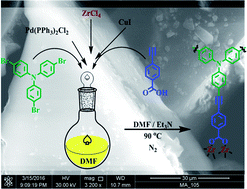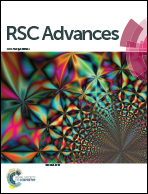One pot synthesis of Zr–carboxylate porous hybrid materials: orthogonal C–C heterocoupling and carboxylate–Zr assembly†
Abstract
We report on a one-pot synthesis of Zr–carboxylate porous polymers. This approach utilized the orthogonality between carboxylate–Zr coordination and C–C cross coupling reactions. The multitopic carboxylate linkers necessary to extend the connectivity of Zr–carboxylate precursors were constructed, in situ, through Sonogashira–Hagihara cross coupling from their molecular precursors. Several halogenated aromatic precursors including the pyridine and pyrimidine derivatives were utilized due to their desirable binding energetics to CO2. The obtained compounds demonstrated permanent porosity as determined by their gas sorption analyses. Several characterization techniques including FTIR, SEM, EDX and solid-state NMR spectroscopy, were utilized to help constructing structure–function relationships. Additionally, impact of chemical composition, specifically incorporation of basic binding sites, on the CO2 affinity to the reported polymers is outlined. The reported isosteric heat of adsorption (37–42 kJ mol−1) for the pyridine and pyrimidine-based solids are among the highest reported for Zr-based MOFs.


 Please wait while we load your content...
Please wait while we load your content...